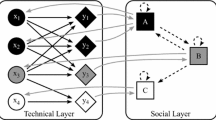Abstract
The design and engineering of large, complex electromechanical artifacts for use in space requires the integration of many engineering groups, spread across the components of the artifact and across the customer and suppliers. And within each engineering group there is a need to integrate the many diverse skills required, such as electrical, mechanical, thermal, software and materials. This paper describes the results of a study conducted from the Summer of1992 through the Fall of1993 at a medium sized aerospace company. The study had two goals. The first goal was to identify project delays that were due to poor coordination and integration. The second goal was to identify the activities which occupy engineers at the company and to rank the activities by the level of frustration and wasted effort encountered in performing them. The first goal was accomplished by studying25 problem cases, compiled and classified into six problem categories: information acquisition (24% of cases), information access (32% of cases), knowledge access (4% of cases), decision interdependence (8% of cases), activity management (12% of cases) and agent access (16% of cases). The delays associated with information acquisition, information access and knowledge access range from 1 day to as much as a year; they range from 1 day to a week for the other categories. The second goal, to identify the activities which occupy engineers and to rank the activities by the frustration and wasted effort encountered, was accomplished by conducting a survey, circulated to 30 engineers across five different departments. The participants were required to track the time spent in seven different activities over an actual 5 day week. They also estimated the time they would spend on these activities in a typical week on a percentage basis. The percentages of time spent were: information gathering (13.7%—actual; 12.2%—typical), problem, solving/thinking (28.0%—actual; 29.8%—typical), documentation (23.5%—actual; 19.5%—typical), planning (7.8%—actual; 8.5%—typical), negotiating (7.6%—actual; 9.8%—typical), support and consulting (17.1%—actual; 18.1%—typical) and other (2.3%—actual; 2.1%—typical). The participants also rated the activities from 1 (most frustrating) to 7 (least frustrating). The average scores, beginning with the most frustrating, were: 3.33-information gathering, 3.48-negotiation, 3.56-documentation, 3.67-support/consulting, 3.9-planning, 4.52-problem solving/thinking and 6.67-other.
Similar content being viewed by others
References
Kitzmiller, C.; Jagannathan, V. (1989) Design in a distributed blackboard framework, Intelligent CAD. I: Proceedings of IFIP TC/WG 5.2 Workshop on Intelligent CAD, North-Holland, Amsterdam, 223–233
Pennell, J.P.; Winner, R.I. (1989) Concurrent engineering: practices and prospects, GLOBECOM '89: IEEE Global Telecommunications Conference and Exhibition—Communications for the 1990s and Beyond, Vol. 1, IEEE, New York, 647–655
Proceedings of the ACM 1992 Conference on Computer-Supported Cooperative Work, Association for Computing Machinery, New York
Crabtree, R.A.; Fox, M.S.; Baid, N. (1994) Towards an understanding of collaborative design activities, Technical Report, Department of Industrial Engineering, University of Toronto Canada
Prasad, B.; Morenc, R.S.; Rangan, R.M. (1992) Information management for concurrent engineering: research issues, Concurrent Engineering: Research and Applications, Vol. 1, The Institute of Concurrent Engineering, 3–20
McNeese, M.D.; Zaff, B.S.; Brown, C.E.; Citera, M.; Wellens, A.R. (1992) The role of a group centered approach in the development of computer supported collaborative design technologies, Proceedings of the Human Factors Society 36th Annual Meeting
Kleinman, D.L. (1990) Coordination in human teams: theories, data, models, IFAC 11th Triennial World Congress, Tallinn, Estonia
Lindeman, D.; Wijaya, L. (1992) Managing design structure data in a concurrent engineering environment, ASME 1992 Conference: Engineering Data Management: Key to Integrated Product Development, New York, 97–104
Biliris, A.; Zhao, H. (1991) Design versions in a distributed CAD environment, Proceedings of the Eighth Annual International Phoenix Conference on Computers and Communication, IEEE Computer Society Press, Washington, DC 354–359
Sinclair, M.A.; Siemieniuch, C.E.; John, P.A. (1989) A user centred approach to define high-level requirements for next-generation CAD systems for mechanical engineering, IEEE Transactions on Engineering Management, 36, 4, 262–270
Thomas, R.; Drury, R. (????) Team Communication in Complex Projects, First International Conference on Engineering Management, 187–197
Garcia, A.C.B.; Howard, H.C. (1992) Acquiring knowledge through design decision justification, AI EDAM, Vol. 6, Issue 1, Academic Press, New York, 59–71
Wallace, K.M., Hales, C. (1987) Detailed analysis of an engineering design project, Proceedings of ICED'87, 94–101
Uejio, W.H.; Carmody, S.; Ross, B. (1991) An electronic project notebook from the electronic design notebook (EDN), General Electric Corporate Research and Development Center, Schenectady, New York.
Louie, J. (1995) An analysis of a pen-based tool for acquiring engineering design information, MSC Thesis, TR-EIL-95-1, Enterprise Integration Laboratory, Industrial Engineering Department, University of Toronto
Boettner, D.; Ward, A. (1992) Design compilers and the labelled interval calculus, Artificial Intelligence in Engineering Design, Vol. I, Academic Press, San Diego, CA
Fox, M.S.; Finger, S.; Gardner, E.; Navin chandra, D.; Safier, S.; Shaw, M. (1992) Design fusion: an architecture for concurrent design, Knowledge Aided Design (Green, M. Editor). Academic Press, San Diego, 157–196
Author information
Authors and Affiliations
Corresponding author
Rights and permissions
About this article
Cite this article
Crabtree, R.A., Fox, M.S. & Baid, N.K. Case studies of coordination activities and problems in collaborative design. Research in Engineering Design 9, 70–84 (1997). https://doi.org/10.1007/BF01596483
Issue Date:
DOI: https://doi.org/10.1007/BF01596483




